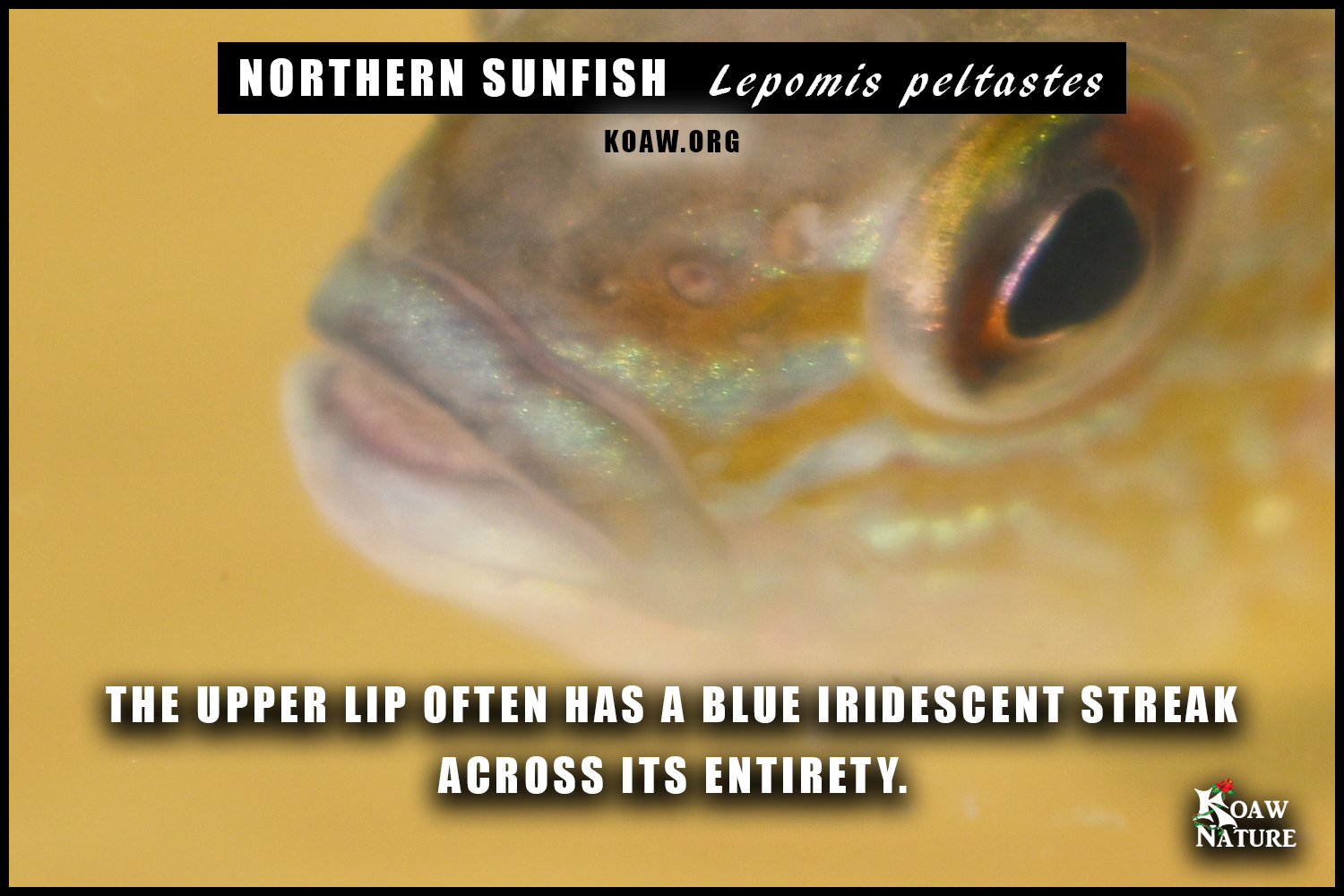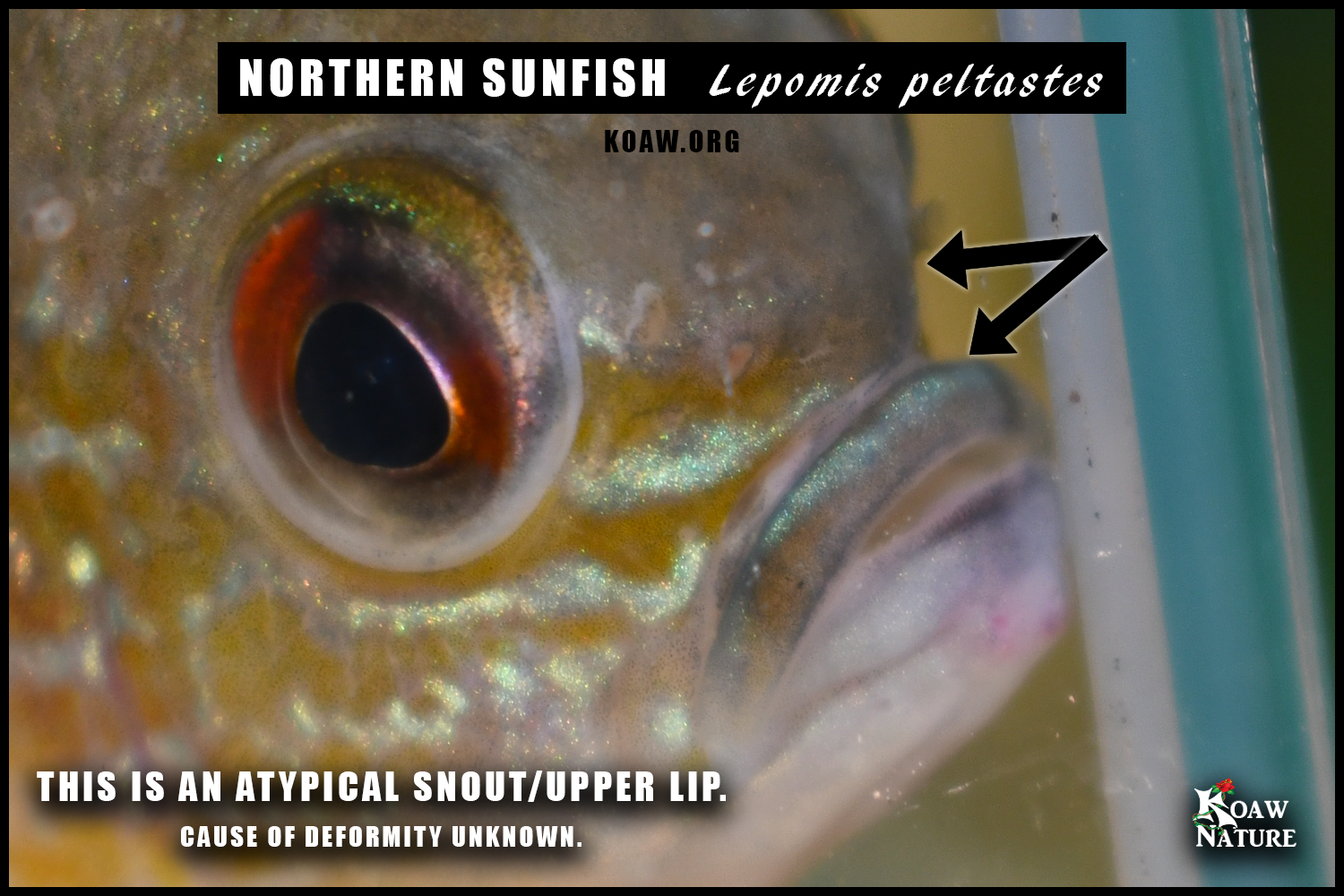By Koaw - October, 2020 (Updated 2022)
GENERAL:
The northern sunfish (Lepomis peltastes - Cope 1869 [1]) is a small species within Lepomis that was once listed as a synonym of the longear sunfish (Lepomis megalotis) and even as a subspecies of L. megalotis as L. megalotis peltastes. [2] Although the northern sunfish was described as a species by Cope in 1869, this fish was not recognized as a distinct species until 2004 when the northern sunfish’s taxonomic promotion to species status apparently occurred without the support of any DNA analyses, [3] [4] only based on the premise that although the longear sunfish and northern sunfish are very similar both genetically and morphologically [5], the two species maintain distinct morphological and behavioral traits.
Complete video with fishing tips, ID tips, & info on the longear species complex splitting.
Currently there is no argument that the northern sunfish (Lepomis peltastes) is a distinct species. Especially solidified as a species by the recent publication on the longear species complex by Kim, Bauer, and Near (2022). [6]
Getting a confident ID will require looking for a very slanted opercular flap (usually between 38-42 degrees) with a red patch, a short pectoral fin, as well as examining the range map. Be advised that genetically admixed specimens with longear sunfish will exist near the southern border of the range. (See the accompanying video and/or range map below.)
Typically presenting 12-13 pectoral rays, 10 dorsal spines, 10-11 dorsal rays, 3 anal spines and 9 (10) anal rays. [4] [7] The lateral line is typically complete but may be broken or interrupted about 25% of the time. [6] Normally there are less than 40 lateral scales. [4]
BODY: The body is similar to other lepomids where it has a deep and compressed body that is shaped somewhat like a disc.
COLORATION: The northern sunfish is a very colorful species when mature, especially breeding males that have much more pronounced colors. Mature specimens are typically dark olive above with a yellow belly. Breeding males may have a very dark red/orange body with a bright yellow/orange belly. Iridescent blue spotting exists along the body. Other spots of orange and brown may also be present along the body. Mature specimens often retain bars that may be faded.
The head has bluish/teal streaking starting on the snout and extending laterally along the cheek and into the gill cover. Most specimens will have a blue streak across the entirety upper lip, though this is not a great feature to use for identification with this species as it may faint or broken.
Often the median fins have iridescent blue flecks with reddish/orange mottling. The dark orange and red mottling in the median fins is a good feature to use to distinguish this species from the pumpkinseed (L. gibbosus.) Often the fins are clear but may be almost entirely colored with reddish orange and blue. The pelvic fin is often dark on breeding males.
Although the eyes do tend to have red around the pupil, this is not an ideal feature to use for identification with any of the sunfishes within Lepomis. Eye color may vary greatly within species as well as within local populations as specimens mature and even due to seasonal changes.
SIZE: To 13 cm (5 in). [4] The northern sunfish is one of the smaller species within the genus. Most adult specimens are between 5-10 cm (2-4 in.)
OPERCULAR FLAP:
The opercular flap on mature specimens usually has a solid reddish orange marking on the back edge. The dorsal and ventral edging of the ear flap is often pale with either a whitish, yellowish or bluish color.
Some male specimens do have rather large ‘ear flaps’ but usually the size is about the length of the eye. The opercular flap tends to slant upwards with an angle around 38 to 42 degrees. [6]
Occasionally the posterior edge will not have any red marking, appearing only with a yellow and pale edging—this is typically when a fish’s system is shocked.
GILL RAKERS: The gill rakers are very short and thick. These are easily seen by lifting the gill cover and looking at the white portion above the red filaments on the gill arch closest to the gill cover.
I made a video describing how to locate and find these rakers that is hosted on Koaw Nature’s Fishing Smarts YouTube channel.
MOUTH SIZE:
The northern sunfish usually has a fairly small mouth. The upper jaw extends almost in alignment with the front of the eye or to the front of the pupil, or more specifically, the posterior edge of the maxilla generally aligns between the anterior edges of the pupil and orbit.
The mouth remains larger than what a pumpkinseed typically shows.
Northern sunfish are also predators of snails, using a technique of grabbing the snail’s foot and quickly flinging the shell off the body with a jerk of the head. [8]
PECTORAL FIN: The pectoral fin is moderately-sized and rounded. If bent forward the pectoral fin typically will not exceed the anterior edge of the eye.
The northern sunfish typically has 12 to 13 pectoral rays. [4] [7]
HABITAT:
This species is often associated with vegetation and near benthic that is rocky or sandy; [2] this species can also be found over muddy benthic. Common in pools of creeks and slow moving rivers. The northern sunfish prefers clean water systems and does not thrive in heavy sediment-laden waters.
In the southern lakes of Michigan it was shown that northern sunfish preferred the exposed marl sediment areas of clear-water lakes while the northern sunfish was absent or rarely found in densely vegetated lakes. [9]
The supporting image shows the exact spot along a river in Ohio where I pulled a number of specimens. I spent a number of hours covering a good stretch of this river. This spot was the only place where northern sunfish were seen on this day. The fair amount of vegetation and higher amount of fallen trees in the water likely made this section more appealing. Only encountering a few specimens on this stretch of river may have been a result of the high turbidity of the water; Hubbs and Lagler (2004, Rev. ed.) suggest this species is not tolerant of siltation, a reason why this species population abundance has been reduced in recent years. [8]
CLICK TO ENLARGE - This distribution map is an illustrated approximation created by Koaw primarily pulling data and information from USGS-NAS, (Vetted) Research Grade observations from iNaturalist, Page & Burr’s Field Guide to Freshwater Fishes as well as Kim, Bauer, & Near (2022).
LOCATION:
This species is confined to a relatively small and scattered territory surrounding the Great Lakes. Exists in the northwest within the Souris-Red-Rainy Basin within the southwestern parts of Ontario and into Minnesota. Scattered populations may still exist within southern Minnesota, upper Wisconsin & Iowa. Uncommon but definitely present in the southeastern parts of Wisconsin and down into the northern areas of Illinois as well as in the Ohio River Basin’s northwest area. Commonly found in the Great Lakes Basin starting in Ohio and into Michigan and into the southern parts of Ontario.
In 2018, a study found that a small population of northern sunfish is in existence near in the Lake Champlain Watershed. [10] This is likely a resurgence of the indigenous population rather than an anthropogenic introduction.
Since the northern sunfish (Lepomis peltastes) was once considered the same species (and a subspecies) of the longear sunfish (Lepomis megalotis), historical accounts of population ranges should be taken into question. I’ve assembled this map upon an estimation combining Page & Burr’s range map as well as research grade observations on iNaturalist, where I vetted outliers. [4] [11] The map has also been updated to reflect genetic inferences from the new Lepomis megalotis study. [6]
Ranges where the longear sunfish and northern sunfish meet and/or overlap will definitely produce introgressed specimens and make identifications trickier. Areas in Ohio, Illinois and Indiana will likely show genetically admixed specimens with the longear sunfish—though mostly northern blood.
FISHING:
Most populations of this species are in decline or already extirpated. I don’t suggest harvesting any northern sunfish. Releasing this little fish is suggested.
After having caught northern sunfish in 4 different states, here is the advice I offer: Smaller is better. I suggest using a size 18-14 hook to capture most adult specimens. A size 12-10 will work for the larger adult specimens. I absolutely love bead-head flies to capture northern sunfish. Also, a hook with a shred of a worm will work great.
See the northern sunfish video I posted (released 6/15/2022) on KN Fishing Smarts on YouTube to really see the fishing methods that will land you this fish.
Summertime northern sunfish have been found to primarily be feeding on the larvae of dragonflies, mayflies as well as on amphipods. [9] I would assume damselfly larvae are also on the menu—so adjusting your flies to match these creatures might benefit you well.
SIMILAR SPECIES:
REFERENCES:
E. D. Cope, "A Partial Synopsis of the Fishes of the Fresh Waters of North Carolina," Proceedings of the American Philosophical Society, vol. 11, no. 81, p. 454, 1869.
R. Fricke, W. N. Eschmeyer and R. van der Laan, "ESCHMEYER'S CATALOG OF FISHES: GENERA, SPECIES, REFERENCES," [Online]. Available: http://researcharchive.calacademy.org/research/ichthyology/catalog/fishcatmain.asp. [Accessed 19 August 2020].
R. M. Bailey, W. C. Latta and G. R. Smith, "An Atlas of Michigan Fishes with Keys and Illustrations for their Identification," Misc. Publications Museum of Zoology, University of Michigan, no. No. 192, pp. i-iv; 1-215, 2004.
L. M. Page and B. M. Burr, Peterson Field Guide to Freshwater Fishes, Houghton Mifflin Harcourt Publishing Company, 2011, pp. 506-507.
M. J. Jennings and D. P. Philipp, "Genetic variation in the longear sunfish (Lepmis megalotis)," CAN. J. ZOO., vol. 70, pp. 1673-1680, 1992.
D. Kim, B. H. Bauer and T. . J. Near, "Introgression and Species Delimitation in the Longear Sunfish Lepomis megalotis (Teleostei: Percomorpha: Centrarchidae)," Syst. Bio., vol. 71, no. 2, pp. 273-285, 2022.
Koaw, "Meristics and Morphometrics of Lepomids," 2020. [Online]. Available: https://www.koaw.org/lepomid-data.
C. L. Hubbs and K. F. Lagler, FISHES of the Great Lakes Region: Revised Edition/ Revised by Gerald R. Smith, The University of Michigan Press, 2004.
D. R. Laughlin and E. E. Werner, "Resource partitioning in two coexisting sunfish: pumpkinseed (Lepomis gibbosus) and northern longear sunfish (Lepomis megalotis peltastes).," Canadian Journal of Fisheries and Aquatic Sciences, vol. 37, pp. 1411-1420, 1980.
E. C. Maxwell and D. M. Carlson, "The First Record of Northern Sunfish (Lepomis peltastes) in the Lake Champlain Watershed," Northeastern Naturalist, vol. 25, no. 1, pp. 181-187, 2018.
iNaturalist, "iNaturalist - Lepomis peltastes Northern Sunfish," [Online]. Available: https://www.inaturalist.org/taxa/358056-Lepomis-peltastes. [Accessed May 2022].



